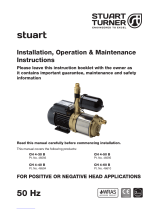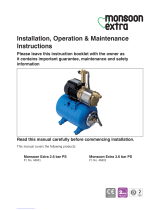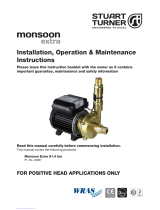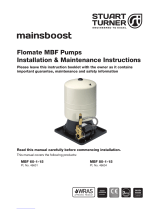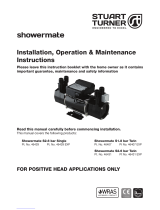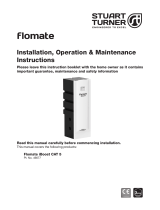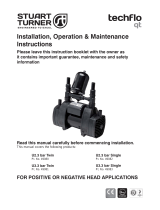Page is loading ...

- 2 -
PRESSURE CONTROL MODELS
Boostamatic 4000
Boostamatic 6000 Boostamatic K7-2 Boostamatic L5-4S
Boostamatic L7-4S
INDEX . . . . . . . . . . . . . . . . . . . . . . . . . . . . . . . . . . . . . . . . . . . . . . . . . . Page No
Application . . . . . . . . . . . . . . . . . . . . . . . . . . . . . . . . . . . . . . . . . . . . . . . . . . . . . . . . . . . . . . . . . . .2
Product Description . . . . . . . . . . . . . . . . . . . . . . . . . . . . . . . . . . . . . . . . . . . . . . . . . . . . . . . . . . . .3
Limits of Application . . . . . . . . . . . . . . . . . . . . . . . . . . . . . . . . . . . . . . . . . . . . . . . . . . . . . . . . . . . .4
Technical Specifi cation . . . . . . . . . . . . . . . . . . . . . . . . . . . . . . . . . . . . . . . . . . . . . . . . . . . . . . . . . 4
Pump Connections . . . . . . . . . . . . . . . . . . . . . . . . . . . . . . . . . . . . . . . . . . . . . . . . . . . . . . . . . . . . 5
Pre Installation Assembly . . . . . . . . . . . . . . . . . . . . . . . . . . . . . . . . . . . . . . . . . . . . . . . . . . . . . . .6
Siting of the Pump/Pipework . . . . . . . . . . . . . . . . . . . . . . . . . . . . . . . . . . . . . . . . . . . . . . . . . . . . .8
Electrical Installation . . . . . . . . . . . . . . . . . . . . . . . . . . . . . . . . . . . . . . . . . . . . . . . . . . . . . . . . . . .11
Noise . . . . . . . . . . . . . . . . . . . . . . . . . . . . . . . . . . . . . . . . . . . . . . . . . . . . . . . . . . . . . . . . . . . . . . .13
Commissioning . . . . . . . . . . . . . . . . . . . . . . . . . . . . . . . . . . . . . . . . . . . . . . . . . . . . . . . . . . . . . . . 13
Maintenance . . . . . . . . . . . . . . . . . . . . . . . . . . . . . . . . . . . . . . . . . . . . . . . . . . . . . . . . . . . . . . . . . 15
Storage . . . . . . . . . . . . . . . . . . . . . . . . . . . . . . . . . . . . . . . . . . . . . . . . . . . . . . . . . . . . . . . . . . . . . 16
Trouble Shooting Guide . . . . . . . . . . . . . . . . . . . . . . . . . . . . . . . . . . . . . . . . . . . . . . . . . . . . . . . . .17
Environment Protection . . . . . . . . . . . . . . . . . . . . . . . . . . . . . . . . . . . . . . . . . . . . . . . . . . . . . . . . .19
IMPORTANT NOTES
Please read these instructions fully before starting the
installation:
The installation must comply with the relevant water supply,
electrical and building regulations and be installed by a
competent person.
If in doubt, consult Stuart Turner Ltd.
APPLICATION
The Pressure Control range is designed for pressure boosting applications in vented
stored hot or cold, clean fresh water systems, where under gravity, no flow is available.
Other clean non aggressive, non explosive liquids with similar characteristics to water may
be pumped, consult Stuart Turner for such applications.
WARNING AGAINST MISUSE
This pump set must not be used for any other application without the
written consent of Stuart Turner Limited and, in particular, must not be
connected directly to the mains water supply or used outside the
conditions specified in the limits of application.
This appliance is not intended for use by persons (including children)
with reduced physical, sensory or mental capabilities, or lack of
experience and knowledge, unless they have been given supervision
or instruction concerning use of the appliance by a person responsible
for their safety.
Children should be supervised to ensure that they do not play with the
appliance.
This product should not be used for the supply of water to more than
one dwelling (house, apartment, flat).

- 3 -
Cont ...
PRODUCT DESCRIPTION
Electric motor driven pump complete with flow switch, pressure switch, pressure vessel
and electronic control.
Motor
Class ‘F’ insulation, totally enclosed fan ventilated cooling, continuously rated.
All motors are induction type, permanent capacitor, fitted with integral auto resetting
thermal overload protection and comply with BS5000 or IEC 34-1. Enclosure ratings are
given in the technical specification section.
Pump
Close coupled to motor.
4000 & 6000 are of single stage, end suction, peripheral design.
K7-2 is of single stage, end suction, centrifugal design.
L5-4S & L7-4S are of four stage, end suction, centrifugal design.
Standard pump materials of construction of major wetted parts are as follows:-
Model Body Impeller Shaft Mechanical Seal
4000 Brass Brass Stainless Steel Nitrile/Carbon/Ceramic
6000 Brass Brass Stainless Steel Nitrile/Carbon/Ceramic
K7-2 Brass Plastic Stainless Steel Nitrile/Carbon/Ceramic
L5-4S Stainless Steel Plastic Stainless Steel Nitrile/Carbon/Silicone
Carbide
L7-4S

- 4 -
Cont ...
Notes:
Max. viscosity: 9.5 centistokes (Redwood No 1 scale).
Max. ambient air temp: 40°C
* With footvalve fitted.
** Max working pressure is the maximum pressure that can be applied to the pump
internal casing under any installation conditions.
*** Maximum permissible liquid temperature 65°C.
**** The supply voltage must not exceed ±10% of the above listed
voltage. eg. 230 ±10% Failure to adhere will damage the unit.
TECHNICAL SPECIFICATION
Note: For information on other voltages/frequencies which are not shown, consult any
supplementary instruction sheet supplied, or the rating label attached to the
pump.
Stuart Turner reserve the right to amend the specification in line with its policy of
continuous development of its products.
LIMITS OF APPLICATION
Model Supply
(Note ****)
Max.
Liquid
Temp.
oC
(Note ***)
Min.
Liquid
Temp.
oC
Max.
Suction
Lift (m)
(Note *)
Max. No.
Starts/h
Cut in
Pressure
(bar)
Cut Out
Flow
(l/min)
Max.
Working
Pressure
kPa (bar)
(Note **)
Max.
Inlet
Head
(m)
Max.
Head
(m)
(pump
closed
valve)
4000 230/1/50 65 4 4.6 60 1.4 1.0 600 (6) 13 29.5
6000 230/1/50 65 4 4.6 60 1.4 1.0 600 (6) 13 41.0
K7-2 230/1/50 65 4 4.6 60 0.8 1.0 600 (6) 8 13.5
L5-4S 230/1/50 65 4 4.6 60 1.8 1.0 700 (7) 13 45.0
L7-4S 230/1/50 65 4 4.6 60 1.8 1.0 700 (7) 13 47.0
Model Supply Max. Watts
Consumed
Nominal
Watts
Output
(Motor)
Full
Load
Current
(AMPS)
Enc.
Rating
Duty
Rating Dims (mm)
Gross
Weight
(packed)
kg
No. of
Pump
Stages
LWH
4000 230/1/50 360 120 1.6 IPX4 Continuous (S1) @
4.5 l/min and above 232 132 292 7.15 1
6000 230/1/50 450 300 2.5 IPX4 Continuous (S1) @
4.5 l/min and above 232 132 292 7.75 1
K7-2 230/1/50 450 360 2.0 IPX4 Continuous (S1) 242 159 302 8.9 1
L5-4S 230/1/50 950 600 4.2 IP44 Continuous (S1) 401 288 355 10.85 4
L7-4S 230/1/50 1055 760 4.9 IP44 Continuous (S1) 425 288 355 10.35 4

- 5 -
Cont ...
PUMP CONNECTIONS
Model Inlet
(Pump)
Outlet Fig. No.
4000 G 1 Female G 1 Female 1
6000 G 1 Female G 1 Female 1
K7-2 G 1 Female G 1 Female 3
L5-4S G 1¼ Female G 1 Female 2
L7-4S G 1¼ Female G 1 Female 2
PUMPS
Fig. 1
Reed Switch
Assembly
Reed Switch
Assembly
Reed Switch
Assembly
Inlet
Inlet
Inlet
Outlet
Outlet
Outlet
Fig. 2 Fig. 3

- 6 -
Cont ...
PRE-INSTALLATION ASSEMBLY
Pressure Check and Assembly of Pressure Vessel
a) Certain models are supplied in two parts, the main pump and the pressure vessel.
The pressure vessel is pre-charged with air at the factory (see table below). This
pressure should be checked at the Schrader valve (Fig. 4) using a tyre pressure
gauge and adjusted if necessary using a car or bicycle pump prior to installation.
b) To assemble the vessel (when applicable), remove protective plastic cap from fitting
point. Ensure that the ‘O’-ring is present and correctly fitted in the location groove at
the bottom of the fitting point. Screw the pressure vessel clockwise into the fitting
point until hand tight to achieve a water tight connection.
NOTE: Do not over tighten pressure vessel.
Fig. 4
Detail view of
‘O’-Ring groove
in fitting point
‘O’-Ring
Schrader valve
(under cap)
Pressure vessel
‘O’-Ring
Fitting point
Model Air Precharge
bar (psi)
All Models 0.9 (13)

- 7 -
Cont ...
Re-positioning of Pressure Vessel
The pressure vessel can be rotated to alternative positions (Figs. 6 & 7) in the event of
the factory fitted position being unsuitable for a specific installation.
a) Remove pressure vessel by unscrewing anti-clockwise.
b) Using a 2 mm allen key, carefully loosen all three retaining grub screws by two
turns (Fig. 5).
c) Warning - Care must be taken when re-positioning the pressure vessel to
ensure no strain is placed upon the pressure
switch or reed switch cables.
The flow switch assembly can now be carefully
rotated to an alternative position
(Figs. 6 & 7).
d) Ensure all three grub screws are
re-tightened securely to a torque of
2.2 Nm (1.62 lbf feet).
e) Re-fit the pressure vessel
ensuring the ‘O’-ring seal is
in place (see pre-installation
section).
Fig. 5
Grub Screws
(3 off)
Outlet Tower can be swivelled at
this joint line after loosening the
3 equi-spaced grub screws
Motor
Motor
Factory fitted position
K7-2, 4000, 6000
Area for alternative fitting positions
Area for alternative fitting positions
Factory fitted position
L5-4S, L7-4S
Fig. 6
Fig. 7

- 8 -
Cont ...
SITING OF THE PUMP/PIPEWORK
WARNINGS:
Pump Location
If possible site the pump in a location where in the unlikely event of a
liquid leak, any spillage is contained or routed to avoid electrics or
areas sensitive to liquid damage.
Care should be taken to protect pump from frost and freezing.
Ensure pipework to and from pump is independently supported to
prevent forces being transferred to inlet and outlet branches of pump.
Do not introduce solder flux to pumps or pump parts manufactured
from plastics. All solder joints should be completed and flux residues
removed prior to pump connection.
Do not allow plastic pump parts to come into contact with oil or
cellulose based paints, paint thinners or strippers, acid based
descalents or aggressive cleaning agents.
The motor casing can become very hot under normal operating
conditions, care should be taken to ensure it cannot be touched
during operation.
Do not allow scale or debris to enter pump. Fit inline strainers to
eliminate the problem in systems at risk.
Always install isolating valves to both suction and delivery pipework.
Do not install a non-return valve, or devices
which contain non-return valves, in the
suction (inlet) pipework to the pump. The
pump must be free to vent to the supply
tanks at all time. Exceptions can be made in the case of
suction lift installations when a footvalve is required, although under
these conditions it is recommended a suitable pressure relief valve is
fitted in the discharge (outlet) pipework from the pump.
General
Locate the pump in a frost free horizontal position where it cannot be sprayed with water
and as close to the liquid source as possible.
The pump enclosure must be ventilated and there should be a minimum clearance of
80 mm between the pump and housing on all sides.
Care must be taken when mounting the pump that any noise is not amplified through
loose panels, pipework or other mounting medium. Noise transmission in pipework can
be reduced by fitting flexible hoses to pump inlet and outlet ports and by placing the pump
on anti-vibration mounting feet. Resilient mounting feet and flexible hoses are available
separately as optional extras, contact Stuart Turner for further details.
Ensure the liquid flow is in the direction of the arrows that are moulded onto the reed
switch assembly (vertically upwards) (Fig. 8).
The pump set must be mounted in the horizontal position on its feet, with the discharge
port in the vertical position and must not be mounted in any other way (on its side for
instance).

- 9 -
To prevent loss of pressure through pipework, use pipe size to match pump whenever
possible, minimising 90° bends.
It must be ensured that storage capacity of the liquid supply is adequate for the flow
rates required by the pump.
The pipework feeds to the storage tank should be of adequate size to ensure
replenishment rate of tanks is sufficient to meet the needs of the pump.
Isolating valves should be fitted in suction and delivery pipework to enable easy isolation
and access to the pump.
When the pump is to be installed in areas where there is a risk of debris or scale build up
within the system, it is recommended that the inlet pipework is fitted with an inline strainer.
Pump Mounted Below Liquid Source (Flooded Suction Installation)
Before deciding where to locate the unit, check to ensure the static inlet head (Fig. 9)
meets the minimum requirement of 1 metre and does not exceed the maximum given in
the limits of application section.
The static outlet head (Fig. 9) must also be within the maximum requirement of
8 metres for the K7-2 model and 13 metres for all other models.
Fig. 8
Flow must be in
direction of flow
switch arrow
(vertically upwards)
Outlet
Fig. 9
Diagram showing typical Pressure Control
installation with flooded suction.
Max. inlet head (consult limits of application section)
Min. inlet head 1 m
Max. outlet head 13 m (except K7-2)
Max. outlet head 8 m (K7-2 only)
Negative
head

- 10 -
Cont ...
Pump Mounted Above Liquid Source (Suction Lift Installation)
The pumps can be used in a suction lift installation providing the height of lift is within the
limits specified in the limits of application section and the liquid to be pumped is cold water
(for applications other than cold water contact Stuart Turner).
Before deciding where to locate the unit, check to ensure the static outlet head (Fig. 10)
does not exceed the maximum requirements of 8 metres for the K7-2 model and 13 metres
for all other models.
A footvalve and strainer must always be used and the suction pipework size must match
the pump.
Lay the suction piping over the shortest possible distance and ensure there is a constant
rise from the liquid source to the pump. Any high spots will cause air pockets to form,
reducing system efficiency.
Ensure all joints in suction pipework are completely airtight. Failure to comply will result
in loss of prime.
The intake of the footvalve/strainer should be positioned such that it cannot be blocked
with debris or silt that are frequently found in the bottom of sumps and wells.
When a footvalve is installed in the suction pipework, it is recommended that suitable
pressure relief valve be fitted in the discharge (outlet) pipework from the pump.
Fig. 10
Diagram showing typical Pressure Control
installation with suction lift.
Max. inlet head (consult limits of application section)
Max. outlet head 13 m (except K7-2)
Max. outlet head 8 m (K7-2 only)

- 11 -
Certain installations may require additional earthing requirements such as supplementary
equipotential bonding. Reference should be made to the relevant regulations concerning
this subject to ensure compliance.
Electrical Connection
The product range is provided with a factory fitted supply cord. This must be
permanently connected to the fixed wiring of the mains supply. Means for disconnection
must be incorporated in the fixed wiring in accordance with the wiring rules.
A suitable method of connection would be via a double pole switched, fused connection
unit complying with BS 1363-4, protected with a fuse (see fuse section).
The connection unit should be mounted in an easily accessible position and should be
labelled if confusion is possible, to allow easy identification of the pump isolating switch.
ELECTRICAL INSTALLATION
WARNINGS:
The electrical installation must be carried out in accordance with the
current national electrical regulations and installed by a competent
person.
In the interests of electrical safety a 30 mA residual current device
(R.C.D.) should be installed in the supply circuit. This may be part of a
consumer unit or a separate unit.
Before starting work on the electrical installation ensure the power
supply is isolated.
This appliance must be earthed.
The motor and wiring must not be exposed to water.
Do not allow the supply cord to contact hot surfaces, including the
motor shell, pump body or pipework. The cord should be safely
routed and secured by cable clips.
The standard pumps are suitable for a supply of 230V, 1 Phase, 50Hz. Other voltages
and frequencies are available on certain models and it is therefore very important to ensure
the voltage and frequency on the pump rating plate matches the supply.
Earthing
This appliance must be earthed via the supply cord.
Copper or metallic pipework must have supplementary earth bonding where the
continuity has been broken by flexible hoses or plastic components. Adjacent suction and
delivery pipes should be fitted with earthing clamps to BS 951 and connected with earthing
wire size 4 mm² (Fig. 11).
Fig. 11
Diagram of
earth continuity
connection.

- 12 -
Cont ...
Wiring
The Wires in the mains lead (supply cord) are coloured in accordance with the following
code:
Green and Yellow: Earth Blue: Neutral Brown: Live
As colours of the core in the new mains lead may not correspond with the coloured
markings identifying the terminals in your connection unit, proceed as follows:
The wire which is coloured Green and yellow must be connected to the terminal marked
with the letter ‘E’ or by the earth symbol or coloured green or green and yellow.
The wire which is coloured Blue must be connected to the terminal marked with the letter
‘N’ or coloured black.
The wire which is coloured Brown must be connected to the terminal marked with the
letter ‘L’ or coloured red.
Wiring Diagrams
The supply cord and internal wiring within the terminal box are routed and
secured to ensure compliance with the electrical standard EN 60335-1. It
is essential that any disturbance of this internal wiring is avoided and the
factory routing and securing of all internal wiring is always maintained.
Fuses
The following fuse size should be used with the appropriate pump:
Model Fuse Size (AMPS)
4000, 6000 5
K7-2
L5-4S, L7-4S 13
MAIN WINDING
THERMOTRIP CAPACITOR
START WINDING
LINK WIRE
BROWN
BLACK
GREEN/
YELLOW
BLUE
BROWN L
MA
N
N
S2 S3 S3 S2
LE
N
FLOWSWITCH
REED (S3)
S1S1
PRESSURE
SWITCH (S1)
230 VAC/1PH/50Hz
SUPPLY
BLUE
N
AM
E
GREEN/YELLOW
BROWN
BLUE
GREEN/YELLOW
CAPACITOR
MOTOR
BLACK
BLACK
BROWN
WHITE
BLUE
N
S2 S3 S3 S2
L
FLOWSWITCH
REED (S3)
S1S1
PRESSURE
SWITCH (S1)
L
N
BROWN
BLUE
230 VAC/1PH/50Hz SUPPLY
Fig. 12 Fig. 13
4000, 6000, K7-2 L5-4S, L7-4S

- 13 -
Cont ...
Supply Cord Replacement
If the supply cord needs to be replaced, cord selection should be chosen in accordance
with the current involved, surrounding conditions and recommended fuse size. For
information on cable fitting and connection, consult the wiring diagram and cable gland
fitting instructions.
Cable Gland Fitting Instructions (Motor Terminal Box)
To enable correct assembly of the cable gland, the ‘O’-ring (Fig. 14 item 1) must be
placed over the cable before the clamping insert (Fig. 14 item 2) can be tightened as
shown.
Note: Cable diameter range:- 6.5 mm to 9.5 mm.
Supply Cord Extension
The pumps are fitted with a supply cord to the following specifications:-
4000, 6000, K7-2:- . . . . . . . . . . . . . . HO5VV-F3 G 0.75 mm² - 6 Amp rating.
L5-4S, L7-4S:- . . . . . . . . . . . . . . . . . HO7RN-F3 G 1.0 mm² - 10 Amp rating.
If the supply cord is to be extended, a cord of the same specification should be used.
Any connections or junction boxes used should be specifically suited for the application
and installed in accordance with the manufacturers instructions.
NOISE
The equivalent continuous A-weighted sound pressure level at a distance of 1 metre
from the pumpset does not exceed 70 dB(A) for all models.
COMMISSIONING
WARNINGS:
The motor casing can become very hot under normal operating
conditions, care should be taken to ensure it cannot be touched
during operation.
Do not run pump without guards and terminal box lids correctly fitted.
Care should be taken to protect the pump from freezing.
The pump chamber must be full of liquid at all times. Seal damage will
result if the pump runs dry.
Fig. 14
L5-4S, L7-4S 4000, 6000, K7-2
1
1
22

- 14 -
Cont ...
1. System Flushing
This pump-set incorporates plastic components that must not come into
contact with solder flux, acid-based descalents or aggressive cleaning
agents. The pipework system should be flushed out prior to the pump being
connected to ensure any contaminants/chemical residues and foreign
bodies are removed from elsewhere in the system.
2. Liquid Supply
Always ensure that liquid storage capacity is adequate to meet the demand.
Ensure the pump chamber is full of liquid before starting the pump. Failure
to do this could result in seal damage. To ensure dry running does not
occur the pumps must be primed as described in priming section. Do not
run pump dry.
3. Ensure electrical supply is compatible with the details that are stated on the pump
rating plate. (The wrong voltage or frequency can be dangerous and may damage
the pump.)
4. Priming
a) Flooded suction installation
The pump must be primed (filled with liquid) before starting. Turn on liquid
supply, prime and vent the pump by unscrewing the priming plug (Figs. 15, 16
& 17) slowly until all air escapes and liquid emerges. Re-tighten plug.
b) Suction lift installation
A footvalve and strainer must be fitted to the end of the inlet pipework. Prime the
suction pipework by filling before connecting to the pump. Prime the pump by
filling via the priming plug (Figs. 15, 16 & 17).
PUMPS
Outlet
Outlet
Outlet
Inlet
Inlet
Inlet
Priming
Plug
Priming
Plug
Priming
Plug
K7-2
Fig. 15
4000, 6000
Fig. 16 L5-4S, L7-4S
Fig. 17

- 15 -
Cont ...
5. Starting The Pump
a) Ensure all outlets are closed, turn power supply ‘on’ - pump will start, pressurise
the system then stop.
b) Open and close all outlets in turn associated with the pump, allowing liquid to
flow from each outlet until all air is purged. As each outlet is opened and closed,
the pump will start and stop respectively.
Note: After closing the outlet there will be a small delay time before the pump
stops, which is normal.
Any tap or control valve within the system when opened and closed will now turn
the pump on/off. Providing this is the case the system is now operating correctly.
c) Carefully check pump and pipework for leaks whilst pump running and stationary
before leaving the installation unattended.
For Further Technical Support
Phone the Stuart Turner Pump Assist team on 0844 98 000 97. Our staff are trained to
help and advise you over the phone or arrange for a service engineer to call.
Note: When pumps are installed in another manufacturers original equipment, please
contact the manufacturer for advice.
MAINTENANCE
WARNINGS:
Care should be taken to protect pump from frost and freezing.
If possible site the pump in a location where in the unlikely event of a
liquid leak, any spillage is contained or routed to avoid electrics or
areas sensitive to liquid damage.
Cleaners, disinfectants and descalents
On installations where chemical disinfectants or descalents are periodically
used, the compatibility of the chemical solution regarding the pump must be
considered.
Acid based descalents and aggressive cleaning agents must not come into
contact with the pump. The pump must be removed from the system prior to the
use of these products. The system should be flushed to remove all chemicals
before the pump is re-connected.
If in any doubt as to the suitability of the chemical solutions refer to Stuart
Turner Ltd.
1. No routine maintenance is required, but provision should be made
for easy access to the pump to allow repairs due to normal wear
and tear.
2. Disconnect electrical supply before working on pump.
3. Turn off liquid supplies to the pump and release pressure by opening liquid outlets
before attempting maintenance.
4. Inlet strainers and footvalve strainers when fitted may require periodical cleaning.
The frequency of this operation is dependent upon installation conditions.

- 16 -
Cont ...
5. As water is heated scale deposits are released in areas of hard water (usually south
of a line between the Wash and Bristol Channel), scale can cause the mechanical
seal to stick if left without use for long periods. We recommend the pump is run for at
least 5 minutes every four weeks to “exercise” all working parts. Run on cool water.
6. After maintenance is completed, refer to the starting and commissioning sections for
instructions on re-starting pump.
STORAGE
If this product is not installed immediately on receipt, ensure that it is stored in a dry, frost
and vibration free location in its original packaging.

- 17 -
Cont ...
TROUBLE SHOOTING GUIDE
Symptoms Probable Cause Recommended Action
Pump will not start. Electrical supply. Check wiring connections.
Check all switches are ‘on’.
Check fuse (see fuse section).
Check circuit breaker is set.
Faulty reed switch/PCB. Refer to circuit test as detailed in Fig. 19
Recommended static inlet/outlet
heads exceeded. Re-position pump (see pump location section).
Internal motor thermotrip
activated. Wait for thermotrip to auto-reset and check that duty point,
run time and ambient temperature are within specification
(see technical specification).
Water starvation to pump. Refer to ‘dry running’ section.
No hot water. Air locked water feed. Vent hot water pump of air.
Check cold feed to hot water cylinder.
Check water level in cold water tank and that all stopcocks
are open.
Boiler is switched off. Check boiler is switched ‘on’.
Check cylinder thermostat.
Check immersion heater.
Check cylinder contains hot water.
All hot water has been used. Check tank volume is adequate.
Faulty thermostatic mixer valve. Consult makers instructions.
Pump starts when outlets are off. Leak in system. Check tap washers, w/c valve washers, pipe joints.
or
Pump cycles (hunts) on/off
frequently.
Low pre-charge pressure in
pressure vessel. Check pre-charge pressure in pressure vessel
(see maintenance section).
Debris under non-return valve
sealing face. Run at full flow to try and flush away debris or remove, clean
or replace non-return valve.
Pump runs on when all terminal
outlets are closed. Leak in system. Check tap washers, w/c valve washers, pipe joints.
Reed clamp out of position. Ensure reed clamp is fitted correctly in location groove
(Fig. 19).
Faulty reed switch or P.C.B. If pump continues to run, this indicates a closed circuit in
either the flow switch reed or P.C.B. in the terminal box, these
should be checked electrically.
Jammed flow switch. Isolate the pump electrically and hydraulically and remove
brass housing that contains the float. Check float for free
movement.
Reduced flow/performance. Blocked inlet strainers. Clean inlet strainers (see maintenance section).
Blocked shower head spray
plate. Clean in accordance with manufacturers instructions.
Blocked pipework or pump. Isolate pump electrically and hydraulically, locate blockage
and remove.

- 18 -
Cont ...
Dry Run Protection
This pump is fitted with a safety control circuit, which will detect the following fault
condition:
Dry running caused by water starvation to the pump.
Should the pump run out of water it will stop as part of a “protective logic sequence”,
detailed below.
The fault should be rectified before re-starting the pump. Check that there is sufficient
water supply to the pump and also ensure that all terminal fitting outlets are closed.
Protective Logic Sequence
If water starvation occurs and the power supply to the pump remains uninterrupted, the
pump controller will perform the following protective sequence.
1. If the pump detects water starvation, it will stop operation after a 1 minute period.
2. The pump will remain in the off condition for a period of 5 minutes.
3. The pump will then re-start and if the water starvation condition remains present, the
pump will then stop operation after a 1 minute period.
4. The pump will remain in the off condition for a period of 5 minutes.
5. The pump will then re-start and if the water starvation condition remains present, the
pump will then stop operation after a 1 minute period.
6. The pump will remain in the off condition for a period of 5 minutes.
7. The pump will then re-start and if the water starvation condition remains present, the
pump will then stop operation after a 1 minute period.
8. After three consecutive resets are performed the pump will remain in the off
condition indefinitely.
9. To restart the pump, the power supply should be first isolated for a period of at least
10 seconds before switching on again.
If the pump fails to operate normally after three attempts to re-start, then please contact
the Pump Assist team on 0844 98 000 97.
Fault Finding
The PCB is also fitted with a “power on” indicator light. This will remain illuminated when
mains power is supplied to the board.
The indicator light is located on the PCB within the terminal box.
This operation should only be carried out by a competent person
To view the light the following procedure must be followed:-
Isolate the mains electrical power supply from the pump.
Remove the four screws retaining the terminal box lid (Fig. 18).
Lift the terminal box lid off.
IMPORTANT – Ensure there is no contact with any of the internal parts of the terminal
box.

- 19 -
Briefly reconnect the mains power supply to the pump – the indicator light should
illuminate if the pump has been correctly wired.
Isolate the mains electrical power supply from the pump.
Re fit the terminal box lid ensuring no cables are trapped.
Re fit the four terminal box lid retaining screws, tighten to 0.8 Nm.
Flow Switch Circuit Test
1. First confirm visually that the flow switch reed clamp have not been dislodged during
handling or installation. The clamp must be fully located within the flow switch body
groove as shown.
2. To carry out the following test you will need to obtain
a magnet, a typical fridge magnet is suitable.
3. Ensure the power supply is switched on.
4. Position the magnet directly in front of the reed
clamp as shown. If pump does not start, then
slowly move the magnet up and down to a
position that exceeds the extent of the reed
clamp. The pump should instantaneously start
at some point during this extent of movement.
If this does not happen, this indicates a possible
fault with the reed switch or the P.C.B which is
located within the terminal box. These should be
checked electrically. Consult Stuart Turner for further instructions.
ENVIRONMENT PROTECTION
Your appliance contains valuable materials which can be recovered or recycled.
At the end of the products’ useful life, please leave it at an appropriate local civic waste
collection point.
Fig. 19
Groove
Body
Reed
Clamp
Magnet
Indication light
Terminal box lid
Retaining screws x 4
Fig. 18 Wiring removed for clarity

Stuart Turner Ltd, Henley-on-Thames, Oxfordshire RG9 2AD ENGLAND
Tel: +44 (0) 1491 572655, Fax: +44 (0) 1491 573704
email: pumps@stuart-turner.co.uk web: www.stuart-turner.co.uk
V.A.T. REG. No. 199 0987 92. Registered in England No. 88368. Registered Offi ce: Market Place, Henley-on-Thames
YOUR 1 YEAR GUARANTEE
Stuart Pumps are guaranteed by Stuart Turner Limited to be free from defects in materials or workmanship for the
applicable guarantee period from the date of purchase. The applicable guarantee period is stated in the installation
booklet supplied with the pump. Within the guarantee period we will repair, free of charge, any defects in the pump
resulting from faults in material or workmanship, repairing, exchanging parts or exchanging the whole unit as we may
reasonably decide.
Not covered by this guarantee: Damage arising from incorrect installation, improper use, unauthorised repair,
normal wear and tear and defects which have a negligible effect on the value or operation of the pump.
Reasonable evidence must be supplied that the pump has been purchased within the applicable guarantee period
prior to the date of claim (such as proof of purchase or the pump serial number).
This guarantee is in addition to your statutory rights as a consumer. If you are in any doubt as to these rights,
please contact your local Trading Standards Department or Citizen’s Advice Bureau.
In the event of a claim please telephone Stuart Turner Limited on 0844 980 0097 or return your pump and flexible
hoses with accessories removed, plugs, pipes etc. If you have any doubt about removing a pump, please consult a
professional.
Proof of purchase should accompany the returned pump to avoid delay in investigation and dealing with your
claim.
DECLARATION OF CONFORMITY
2006/42/EC
BS EN ISO 12100-1, BS EN ISO 12100-2, BS EN 809
2006/95/EC
BS EN 60335-1, BS EN 60335-2-41
2004/108/EC
BS EN 55014-1, BS EN 55014-2, BS EN 55022, BS EN 61000-3-2, BS EN 61000-3-3,
BS EN 61000-4-2, BS EN 61000-4-3, BS EN 61000-4-4, BS EN 61000-4-5, BS EN 61000-4-6,
BS EN 61000-4-11
1999/519/EC
BS EN 62233
2011/65/EU
IT IS HEREBY CERTIFIED THAT THE STUART ELECTRIC MOTOR DRIVEN PUMP AS
SERIAL NUMBER BELOW, COMPLIES WITH THE ESSENTIAL REQUIREMENTS OF THE
ABOVE E.E.C. DIRECTIVES.
RESPONSIBLE PERSON
AND MANUFACTURER STUART TURNER LIMITED
HENLEY-ON-THAMES, OXFORDSHIRE
RG9 2AD ENGLAND.
Signed . . . . . . . . . . . . . . . . . . . . . . . . . . . . . . . . . . . . . . . . . Business Development Director
Stuart Turner are an approved company to BS EN ISO 9001:2000
Issue No. 2612/1-05 Pt. No. 19318
/


